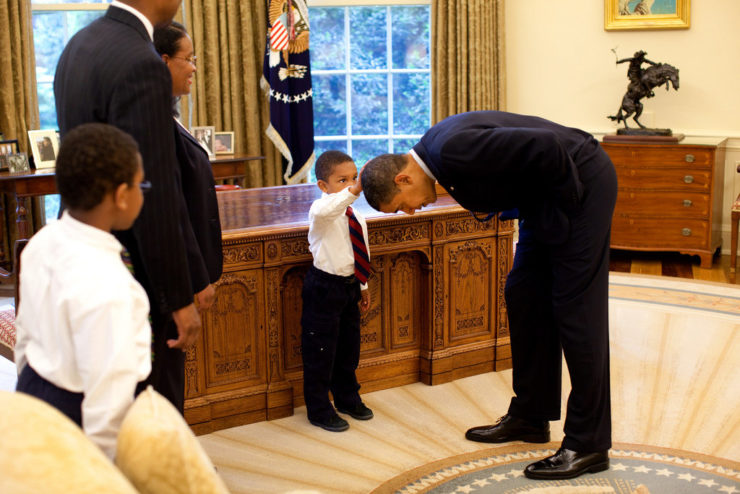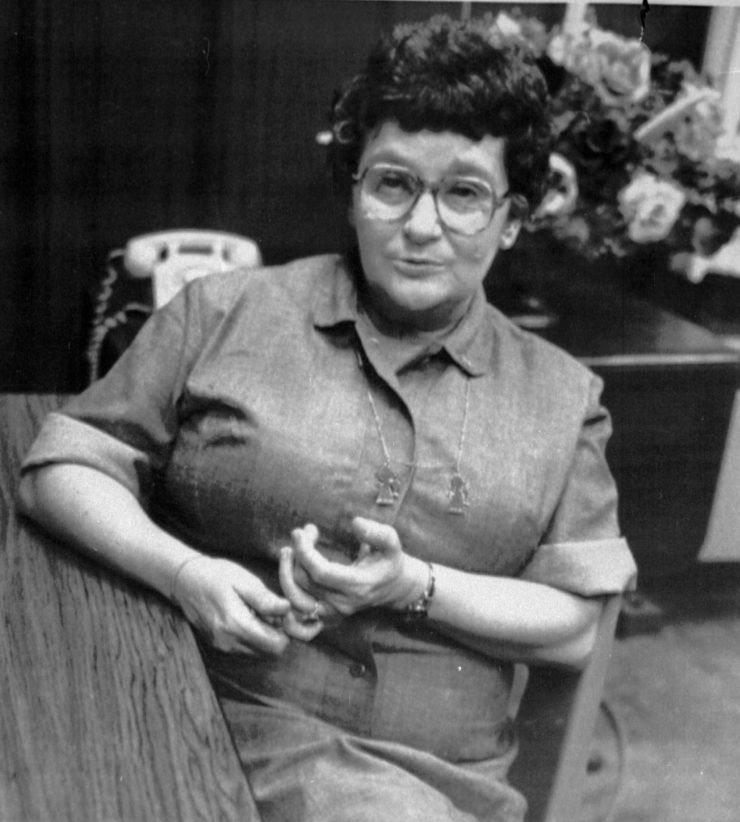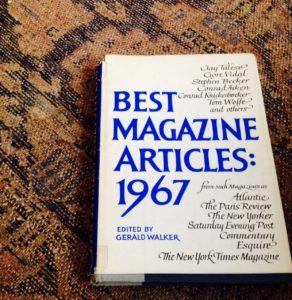
President Obama wipes his tears at his farewell address last week.
Just in time for the weekend, here’s a little list of some of the things I’ve been listening to and reading this week, some of it online — Storyboard included, natch — and some of it on vinyl or actual ink and paper.
Two of my biggest loves are narrative journalism and music, and I’m lucky that my days are filled with both. When reading stories, I get inspired by songs I think fit the article’s theme — a soundtrack. To start out, here are a couple of this week’s Storyboard articles, and their soundtracks:

President Obama lets a little boy touch his hair. The boy, a son of a staffer, wanted to know if his hair was just like the president's.
Why’s This So Good? Ta-Nehisi Coates and “My President Was Black.” This is a very special Why’s This So Good? When Obama was elected in 2008, the Los Angeles Times (where I then worked) sold reproductions of the plate of that day’s front page. Like the hundreds if not thousands of people who lined up around the Times building, I bought one to mark a historic moment. In the bottom right-hand corner there’s a story by columnist Sandy Banks, who wrote about her hopes and fears as an African American woman as the election neared, and her joy on the night Americans chose Obama as their first black president. Eight years later, it seemed a poignant bookend for Sandy to talk about what the Ta-Nehisi Coates piece “My President Was Black,” and the presidency itself, meant to her. Read it. Trust me.
The soundtrack: The first thing I saw after reading “My President Was Black” was a link on Twitter to Nina Simone singing “To Be Young, Gifted and Black” to four children on a stoop on an episode of “Sesame Street.” It was so powerful to see Simone in all her glory, her arms around the next generation. (Watch for the little girl on her right singing along.)

Condemned killer Velma Barfield in 1984.
Annotation Tuesday! Kathy Sawyer and the execution of the “Death Row Granny.” When journalist Roy Rivenburg was in grad school more than 30 years ago, he clipped out this story by Kathy Sawyer on the execution of the first woman put to death in America in decades. He thought it was a great example of how to transform a breaking news story with vivid narrative details. It still holds up as a great example, and he still has the (now-yellowed) clipping. Kathy had to go deep in her memory banks to recall the writing process, and she offers this wonderful tip to writers hoping to do this kind of story: “An editor once told me to conceive of these sorts of stories as if they were ‘letters to your mother.’ That sometimes helps me decide quickly what’s important.”
The soundtrack: “Gary Gilmore’s Eyes,” by the Adverts. By the band whose first hit was the self-mocking “One Chord Wonders,” this is two minutes of punk frenzy. (Loved how the punks refused to make their songs stretch out to the traditional three minutes.) And speaking of Gary Gilmore, if you haven’t read “The Executioner’s Song” by Norman Mailer, do it now. I’ll wait.
One Great Sentence. This week we launched a feature on Storyboard I’m very excited about. It’s called One Great Sentence, and it will spotlight a bite-sized piece of great writing. (Because I don’t love limits that much, sometimes it will be two or even three sentences, if they’re in a groove together.) We’re going to put it in this pretty terrific BIG RED font so it really buys your eye. Then we’ll tell you who wrote it, and, briefly, why we think it’s great. The sentences will come from just about anywhere: stories, books (fiction and non), poetry, movies, you name it. I know that longform is a big time commitment, and we don’t always have that. But we all have time for a sentence, right? That’s the other thing I love about this feature. I want readers to offer One Great Sentences of their own. We’ll tweet them, and even publish them on the site. Let your literary critic flag fly! For the first one, we went with the first sentence of one of the most famous magazine articles ever: Gay Talese’s “Frank Sinatra Has a Cold.”
What I’m reading online: First off, all journalists should read this “Open letter to Trump from the US press corps,” by the editor-in-chief of the Columbia Journalism Review, Kyle Pope. The ending is perfect: “We’ve been around since the founding of the republic, and our role in this great democracy has been ratified and reinforced again and again and again. You have forced us to rethink the most fundamental questions about who we are and what we are here for. For that we are most grateful.”
On a less political note, this elegy to the “Pioneer Cabin Tree” by Nathan Heller in the New Yorker is incredibly touching, its sorrow magnified by the memories of his childhood visiting the tree, and the childhoods of millions of others. He writes, “It was our tree, our human tree, the one we singled out and marked with the illusions of our time.” It makes me think of that haunting scene in “In the Mood for Love” about whispering the secret you cannot share with anyone into the hollow of a tree.
 What’s on my bedside table: I usually read fiction, as a little respite from my work, but this week I thought I’d read something work-related. In fact, it’s from the Nieman Foundation library. (Yes, it’s a cool place to work.) It’s “Best Magazine Articles: 1967.” It’s a who’s who of New Journalism, including Tom Wolfe and Gay Talese, whose article is wondrously titled, “‘Joe,’ said Marilyn Monroe, just back from Korea, ‘you never heard such cheering.’ ‘Yes I have,’ Joe DiMaggio answered.” But one thing irks: The cover lists six of the writers’ names, and then says “and others.” The six names are all men, and one of the “others” is Joan Didion, whose classic article “How Can I Tell Them There’s Nothing Left?” is one of the best in the collection. Behold this perfect line: “Of course she came from somewhere else, came off the prairie in search of something she had seen in a movie or heard on the radio, for this is a Southern California story.”
What’s on my bedside table: I usually read fiction, as a little respite from my work, but this week I thought I’d read something work-related. In fact, it’s from the Nieman Foundation library. (Yes, it’s a cool place to work.) It’s “Best Magazine Articles: 1967.” It’s a who’s who of New Journalism, including Tom Wolfe and Gay Talese, whose article is wondrously titled, “‘Joe,’ said Marilyn Monroe, just back from Korea, ‘you never heard such cheering.’ ‘Yes I have,’ Joe DiMaggio answered.” But one thing irks: The cover lists six of the writers’ names, and then says “and others.” The six names are all men, and one of the “others” is Joan Didion, whose classic article “How Can I Tell Them There’s Nothing Left?” is one of the best in the collection. Behold this perfect line: “Of course she came from somewhere else, came off the prairie in search of something she had seen in a movie or heard on the radio, for this is a Southern California story.”
 What’s on my turntable: Although I spend most of my time listening to music on Spotify, sometimes I want to hear the needle touching down on vinyl. This week’s vinyl: “Nighthawks at the Diner,” by Tom Waits. Talk about great storytelling — Waits might be unmatched in the pop music world. (OK, there’s Leonard Cohen and Bruce Springsteen and Paul Westerberg, but you get the idea.) How about this riff, which has a touch of the Kerouac to it: “I’m across town from EASY STREET/with the tight knots of moviegoers and out of towners on the stroll/and the buildings towering high above/lit like dominoes or black dice/all the used car salesmen dressed up in Purina Checkerboard slacks/and Foster Grant wrap-around/pacing in front of rainbow EARL SCHEIB $29.95 merchandise.”
What’s on my turntable: Although I spend most of my time listening to music on Spotify, sometimes I want to hear the needle touching down on vinyl. This week’s vinyl: “Nighthawks at the Diner,” by Tom Waits. Talk about great storytelling — Waits might be unmatched in the pop music world. (OK, there’s Leonard Cohen and Bruce Springsteen and Paul Westerberg, but you get the idea.) How about this riff, which has a touch of the Kerouac to it: “I’m across town from EASY STREET/with the tight knots of moviegoers and out of towners on the stroll/and the buildings towering high above/lit like dominoes or black dice/all the used car salesmen dressed up in Purina Checkerboard slacks/and Foster Grant wrap-around/pacing in front of rainbow EARL SCHEIB $29.95 merchandise.”
If you want to chat about storytelling (or music), you can reach me at editor@niemanstoryboard.org. Or you can find me at @karihow on Twitter.


